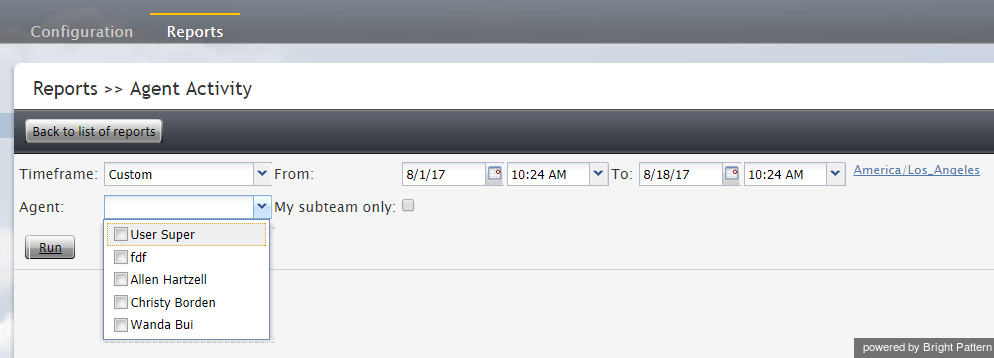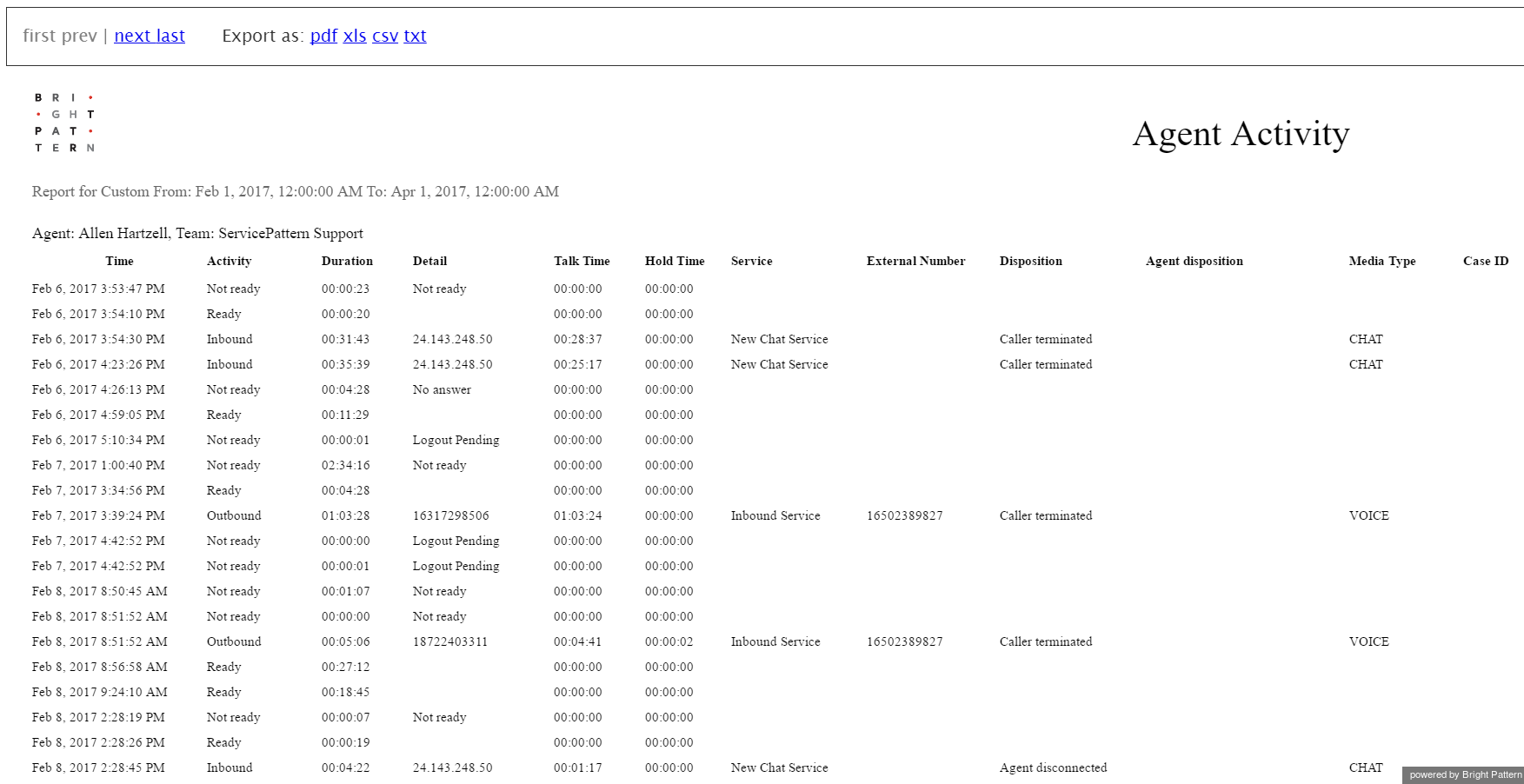Agent Activity Report
The Agent Activity report provides detailed records of activities of selected agents in chronological order. These details are called metrics.
You can narrow the report's data by specifying the following parameters:
- Timeframe - This is the specified time range for which the data will be generated on the report (i.e., Today, This week, Custom, etc.).
- From - If the Custom timeframe is selected, From is the custom date range.
- Timezone - Clicking the link shown allows you to designate the timezone settings for the report's timeframe.
- Agent - The drop-down menu displays the agent(s) who have activity to report.
- My subteam only - Selecting this checkbox will run a report for agents selected for a supervisor's subteam.
Metric Descriptions
The metrics of this report are organized into columns, which are described as follows in the order in which they appear in the report.
Time
Time is the time when the activity started. Only the activities that started within the selected reporting interval will be shown.
Time is given in the Universal Coordinated Time (UTC) time zone.
Activity
Activity is the activity type, which can be one of the following:
- Ready
- Not Ready
- Inbound
- Outbound
- Conference
Duration
Duration is the time spent in this activity. For interaction processing activities, duration includes both in-focus and out-of-focus time, as well as After Call Work (ACW) time.
Time is given in the Universal Coordinated Time (UTC) time zone.
Detail
- For the Outbound activity, Detail displays the extension of the called party if the call was made internally and was answered.
- For the Inbound activity, Detail displays remote party’s the Caller ID for calls, IP address for chats, and email address for emails.
- For the Not Ready activity, Detail displays the reason for being Not Ready if one is specified (otherwise, generic Not Ready).
Talk Time
- For calls, Talk Time is the total time the agent spent talking during this activity, excluding hold times.
- For emails and chats, Talk Time is the total time that the agent had the interaction in focus during this activity.
Note that Talk Time is displayed for interaction-handling activities only, and time is given in the Universal Coordinated Time (UTC) time zone.
Hold Time
- For calls, Hold Time is the total time the agent had the call on hold during the activity.
- For emails and chats, Hold Time is the total time that the agent had the interaction out of focus during this activity.
Note that Hold Time is displayed for interaction-handling activities only, and time is given in the Universal Coordinated Time (UTC) time zone.
Service
For an interaction-handling activity, Service displays the name of the service associated with this interaction.
External Number
- For an Inbound activity, External Number displays the originally dialed number or original destination email address.
- For an Outbound activity, External Number displays the caller ID or the content of the "From" field of the email when it left the system.
Disposition
For interaction-handling activity, Disposition provides information about how the activity ended. Such Dispositions are described as follows:
- Caller Terminated: Inbound call/chat was terminated by the customer
- Callee Terminated: Outbound call/chat was terminated by the customer
- Agent Disconnected: Call/chat was terminated by the agent
- Rejected: Interaction was rejected by the agent
- No Answer: Interaction was not accepted by the agent
- Busy: Outbound call did not complete because the destination was busy or did not answer within a timeout
- Network Failure: Outbound call did not complete because of network congestion
- System Disconnected: Call/chat was disconnected by the system
- Abandoned: Outbound call was terminated by the agent before it was answered
- Transferred: Remote party on the interaction changed due to a transfer (the after-transfer phase is shown as a subsequent activity)
- Terminated by Transfer: Agent transferred the interaction
- Conferenced: Call/chat became a conference (the conference phase is shown as a subsequent activity)
- Replied: Inbound email was replied to by the agent
- Closed: Inbound email was closed without reply by the agent
- Service Changed: Email was recategorized by the agent (service associated with the email was changed and the same agent continued processing it; subsequent email processing is shown as a separate activity)
- Sent: Outbound email was sent by the agent
- Discarded: Outbound email was discarded without being sent by the agent
- Saved: Email was saved as a draft in the agent’s personal queue
Agent disposition
For an interaction-handling activity, Agent disposition displays the disposition assigned to the call by this agent.
Media type
For an interaction-handling activity, Media type displays the interaction media type.
Case ID
For an interaction-handling activity, Case ID displays the identifier of the case that this interaction is related to. It currently applies to email interactions only.


